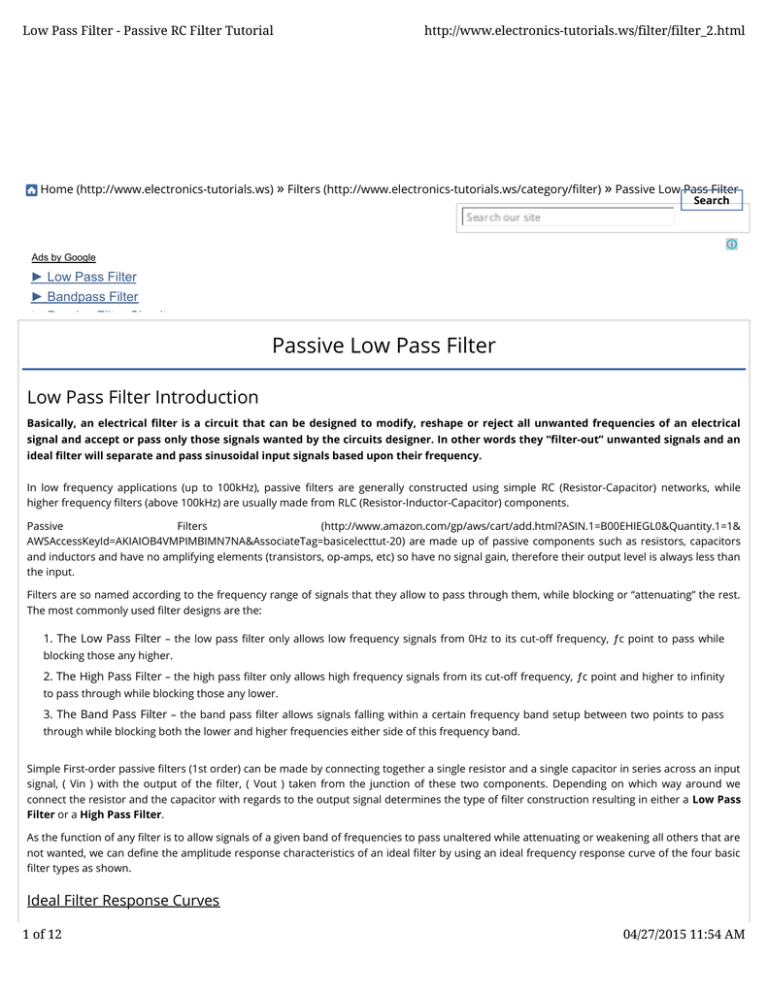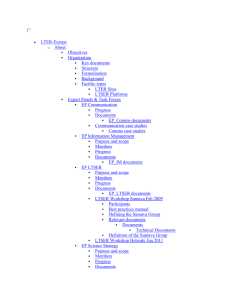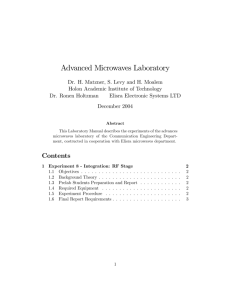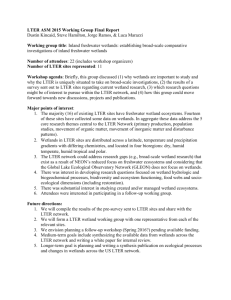
Low Pass Filter - Passive RC Filter Tutorial
http://www.electronics-tutorials.ws/filter/filter_2.html
Home (http://www.electronics-tutorials.ws) » Filters (http://www.electronics-tutorials.ws/category/�lter) » Passive Low Pass Filter
Search
Ads by Google
► Low Pass Filter
► Bandpass Filter
► Passive Filter Circuit
Passive Low Pass Filter
Low Pass Filter Introduction
Basically, an electrical �lter is a circuit that can be designed to modify, reshape or reject all unwanted frequencies of an electrical
signal and accept or pass only those signals wanted by the circuits designer. In other words they “�lter-out” unwanted signals and an
ideal �lter will separate and pass sinusoidal input signals based upon their frequency.
In low frequency applications (up to 100kHz), passive �lters are generally constructed using simple RC (Resistor-Capacitor) networks, while
higher frequency �lters (above 100kHz) are usually made from RLC (Resistor-Inductor-Capacitor) components.
Passive
Filters
(http://www.amazon.com/gp/aws/cart/add.html?ASIN.1=B00EHIEGL0&Quantity.1=1&
AWSAccessKeyId=AKIAIOB4VMPIMBIMN7NA&AssociateTag=basicelecttut-20) are made up of passive components such as resistors, capacitors
and inductors and have no amplifying elements (transistors, op-amps, etc) so have no signal gain, therefore their output level is always less than
the input.
Filters are so named according to the frequency range of signals that they allow to pass through them, while blocking or “attenuating” the rest.
The most commonly used �lter designs are the:
1. The Low Pass Filter – the low pass �lter only allows low frequency signals from 0Hz to its cut-o� frequency, ƒc point to pass while
blocking those any higher.
2. The High Pass Filter – the high pass �lter only allows high frequency signals from its cut-o� frequency, ƒc point and higher to in�nity
to pass through while blocking those any lower.
3. The Band Pass Filter – the band pass �lter allows signals falling within a certain frequency band setup between two points to pass
through while blocking both the lower and higher frequencies either side of this frequency band.
Simple First-order passive �lters (1st order) can be made by connecting together a single resistor and a single capacitor in series across an input
signal, ( Vin ) with the output of the �lter, ( Vout ) taken from the junction of these two components. Depending on which way around we
connect the resistor and the capacitor with regards to the output signal determines the type of �lter construction resulting in either a Low Pass
Filter or a High Pass Filter.
As the function of any �lter is to allow signals of a given band of frequencies to pass unaltered while attenuating or weakening all others that are
not wanted, we can de�ne the amplitude response characteristics of an ideal �lter by using an ideal frequency response curve of the four basic
�lter types as shown.
Ideal Filter Response Curves
1 of 12
04/27/2015 11:54 AM
Low Pass Filter - Passive RC Filter Tutorial
http://www.electronics-tutorials.ws/filter/filter_2.html
Filters can be divided into two distinct types: active �lters and passive �lters. Active �lters contain amplifying devices to increase signal strength
while passive do not contain amplifying devices to strengthen the signal. As there are two passive components within a passive �lter design the
output signal has a smaller amplitude than its corresponding input signal, therefore passive RC �lters attenuate the signal and have a gain of
less than one, (unity).
A Low Pass Filter can be a combination of capacitance, inductance or resistance intended to produce high attenuation above a speci�ed
frequency and little or no attenuation below that frequency. The frequency at which the transition occurs is called the “cuto�” frequency. The
simplest low pass �lters consist of a resistor and capacitor but more sophisticated low pass �lters have a combination of series inductors and
parallel capacitors. In this tutorial we will look at the simplest type, a passive two component RC low pass �lter.
The Low Pass Filter
A simple passive RC Low Pass Filter or LPF, can be easily made by connecting together in series a single Resistor with a single Capacitor as
shown below. In this type of �lter arrangement the input signal ( Vin ) is applied to the series combination (both the Resistor and Capacitor
together) but the output signal ( Vout ) is taken across the capacitor only. This type of �lter is known generally as a “�rst-order �lter” or “one-pole
�lter”, why �rst-order or single-pole?, because it has only “one” reactive component, the capacitor, in the circuit.
RC Low Pass Filter Circuit
As mentioned previously in the Capacitive Reactance (http://www.electronics-tutorials.ws/�lter/�lter_1.html) tutorial, the reactance of a
capacitor varies inversely with frequency, while the value of the resistor remains constant as the frequency changes. At low frequencies the
capacitive reactance, ( Xc ) of the capacitor will be very large compared to the resistive value of the resistor, R. This means that the voltage
potential, Vc across the capacitor will be much larger than the voltage drop, Vr developed across the resistor. At high frequencies the reverse is
true with Vc being small and Vr being large due to the change in the capacitive reactance value.
While the circuit above is that of an RC Low Pass Filter circuit, it can also be classed as a frequency variable potential divider circuit similar to the
one we looked at in the Resistors (http://www.electronics-tutorials.ws/resistor/res_3.html) tutorial. In that tutorial we used the following
equation to calculate the output voltage for two single resistors connected in series.
We also know that the capacitive reactance of a capacitor in an AC circuit is given as:
2 of 12
04/27/2015 11:54 AM
Low Pass Filter - Passive RC Filter Tutorial
http://www.electronics-tutorials.ws/filter/filter_2.html
Opposition to current �ow in an AC circuit is called impedance, symbol Z and for a series circuit consisting of a single resistor in series with a
single capacitor, the circuit impedance is calculated as:
Then by substituting our equation for impedance above into the resistive potential divider equation gives us:
RC Potential Divider Equation
So, by using the potential divider equation of two resistors in series and substituting for impedance we can calculate the output voltage of an RC
Filter for any given frequency.
Low Pass Filter Example No1
A Low Pass Filter circuit consisting of a resistor of 4k7Ω in series with a capacitor of 47nF is connected across a 10v sinusoidal supply. Calculate
the output voltage ( Vout ) at a frequency of 100Hz and again at frequency of 10,000Hz or 10kHz.
Voltage Output at a Frequency of 100Hz.
Voltage Output at a Frequency of 10,000Hz (10kHz).
Frequency Response
We can see from the results above, that as the frequency applied to the RC network increases from 100Hz to 10kHz, the voltage dropped across
3 of 12
04/27/2015 11:54 AM
Low Pass Filter - Passive RC Filter Tutorial
http://www.electronics-tutorials.ws/filter/filter_2.html
the capacitor and therefore the output voltage ( Vout ) from the circuit decreases from 9.9v to 0.718v.
By plotting the networks output voltage against di�erent values of input frequency, the Frequency Response Curve or Bode Plot function of
the low pass �lter circuit can be found, as shown below.
Frequency Response of a 1st-order Low Pass Filter
The Bode Plot shows the Frequency Response of the �lter to be nearly �at for low frequencies and all of the input signal is passed directly to
the output, resulting in a gain of nearly 1, called unity, until it reaches its Cut-o� Frequency point ( ƒc ). This is because the reactance of the
capacitor is high at low frequencies and blocks any current �ow through the capacitor.
After this cut-o� frequency point the response of the circuit decreases to zero at a slope of -20dB/ Decade or (-6dB/Octave) “roll-o�”. Note that
the angle of the slope, this -20dB/ Decade roll-o� will always be the same for any RC combination.
Any high frequency signals applied to the low pass �lter circuit above this cut-o� frequency point will become greatly attenuated, that is they
rapidly decrease. This happens because at very high frequencies the reactance of the capacitor becomes so low that it gives the e�ect of a short
circuit condition on the output terminals resulting in zero output.
Then by carefully selecting the correct resistor-capacitor combination, we can create a RC circuit that allows a range of frequencies below a
certain value to pass through the circuit una�ected while any frequencies applied to the circuit above this cut-o� point to be attenuated,
creating what is commonly called a Low Pass Filter.
For this type of “Low Pass Filter” circuit, all the frequencies below this cut-o�, ƒc point that are unaltered with little or no attenuation and are
said to be in the �lters Pass band zone. This pass band zone also represents the Bandwidth of the �lter. Any signal frequencies above this point
cut-o� point are generally said to be in the �lters Stop band zone and they will be greatly attenuated.
This “Cut-o�”, “Corner” or “Breakpoint” frequency is de�ned as being the frequency point where the capacitive reactance and resistance are
equal, R = Xc = 4k7Ω. When this occurs the output signal is attenuated to 70.7% of the input signal value or -3dB (20 log (Vout/Vin)) of the input.
Although R = Xc, the output is not half of the input signal. This is because it is equal to the vector sum of the two and is therefore 0.707 of the
input.
As the �lter contains a capacitor, the Phase Angle ( Φ ) of the output signal LAGS behind that of the input and at the -3dB cut-o� frequency ( ƒc )
4 of 12
04/27/2015 11:54 AM
Low Pass Filter - Passive RC Filter Tutorial
http://www.electronics-tutorials.ws/filter/filter_2.html
is -45o out of phase. This is due to the time taken to charge the plates of the capacitor as the input voltage changes, resulting in the output
voltage (the voltage across the capacitor) “lagging” behind that of the input signal. The higher the input frequency applied to the �lter the more
the capacitor lags and the circuit becomes more and more “out of phase”.
The cut-o� frequency point and phase shift angle can be found by using the following equation:
Cut-o� Frequency and Phase Shift
Then for our simple example of a “Low Pass Filter” circuit above, the cut-o� frequency (ƒc) is given as 720Hz with an output voltage of 70.7% of
the input voltage value and a phase shift angle of -45o.
Second-order Low Pass Filter
Thus far we have seen that simple �rst-order RC low pass �lters can be made by connecting a single resistor in series with a single capacitor.
This single-pole arrangement gives us a roll-o� slope of -20dB/decade attenuation of frequencies above the cut-o� point at ƒ-3dB . However,
sometimes in �lter circuits this -20dB/decade (-6dB/octave) angle of the slope may not be enough to remove an unwanted signal then two
stages of �ltering can be used as shown.
Second-order Low Pass Filter
The above circuit uses two passive �rst-order low pass �lters connected or “cascaded” together to form a second-order or two-pole �lter
network. Therefore we can see that a �rst-order low pass �lter can be converted into a second-order type by simply adding an additional RC
network to it and the more RC stages we add the higher becomes the order of the �lter. If a number ( n ) of such RC stages are cascaded
together, the resulting RC �lter circuit would be known as an “nth-order” �lter with a roll-o� slope of “n x -20dB/decade”.
So for example, a second-order �lter would have a slope of -40dB/decade (-12dB/octave), a fourth-order �lter would have a slope of
-80dB/decade (-24dB/octave) and so on. This means that, as the order of the �lter is increased, the roll-o� slope becomes steeper and the actual
stop band response of the �lter approaches its ideal stop band characteristics.
Second-order �lters are important and widely used in �lter designs because when combined with �rst-order �lters any higher-order n th-value
�lters can be designed using them. For example, a third order low-pass �lter is formed by connecting in series or cascading together a �rst and a
second-order low pass �lter.
But there is a downside too cascading together RC �lter stages. Although there is no limit to the order of the �lter that can be formed, as the
order increases, the gain and accuracy of the �nal �lter declines. When identical RC �lter stages are cascaded together, the output gain at the
required cut-o� frequency ( ƒc ) is reduced (attenuated) by an amount in relation to the number of �lter stages used as the roll-o� slope
increases. We can de�ne the amount of attenuation at the selected cut-o� frequency using the following formula.
Passive Low Pass Filter Gain at ƒc
5 of 12
04/27/2015 11:54 AM
Low Pass Filter - Passive RC Filter Tutorial
http://www.electronics-tutorials.ws/filter/filter_2.html
where "n" is the number of �lter stages.
So for a second-order passive low pass �lter the gain at the corner frequency ƒc will be equal to 0.7071 x 0.7071 = 0.5Vin (-6dB), a third-order
passive low pass �lter will be equal to 0.353Vin (-9dB), fourth-order will be 0.25Vin (-12dB) and so on. The corner frequency, ƒc for a
second-order passive low pass �lter is determined by the resistor/capacitor (RC) combination and is given as.
2nd-Order Filter Corner Frequency
In reality as the �lter stage and therefore its roll-o� slope increases, the low pass �lters -3dB corner frequency point and therefore its pass band
frequency changes from its original calculated value above by an amount determined by the following equation.
2nd-Order Low Pass Filter -3dB Frequency
where ƒc is the calculated cut-o� frequency, n is the �lter order and ƒ-3dB is the new -3dB pass band frequency as a result in the increase of the
�lters order.
Then the frequency response (bode plot) for a second-order low pass �lter assuming the same -3dB cut-o� point would look like:
Frequency Response of a 2nd-order Low Pass Filter
In practice, cascading passive �lters together to produce larger-order �lters is di�cult to implement accurately as the dynamic impedance of
each �lter order a�ects its neighbouring network. However, to reduce the loading e�ect we can make the impedance of each following stage 10x
the previous stage, so R2 = 10 x R1 and C2 = 1/10th C1. Second-order and above �lter networks are generally used in the feedback circuits of
op-amps, making what are commonly known as Active Filters (http://www.electronics-tutorials.ws/�lter/�lter_5.html) or as a phase-shift
network in RC Oscillator (http://www.electronics-tutorials.ws/oscillator/rc_oscillator.html) circuits.
Low Pass Filter Summary
6 of 12
04/27/2015 11:54 AM
Low Pass Filter - Passive RC Filter Tutorial
http://www.electronics-tutorials.ws/filter/filter_2.html
So to summarize, the Low Pass Filter has a constant output voltage from D.C. (0Hz), up to a speci�ed Cut-o�
frequency, ( ƒc ) point. This cut-o� frequency point is 0.707 or -3dB ( dB = -20log Vout/Vin ) of the voltage gain
allowed to pass.
The frequency range “below” this cut-o� point ƒc is generally known as the Pass Band as the input signal is
allowed to pass through the �lter. The frequency range “above” this cut-o� point is generally known as the Stop
Band as the input signal is blocked or stopped from passing through.
A simple 1st order low pass �lter can be made using a single resistor in series with a single non-polarized capacitor
(or any single reactive component) across an input signal Vin, whilst the output signal Vout is taken from across
the capacitor.
The cut-o� frequency or -3dB point, can be found using the standard formula, ƒc = 1/(2πRC). The phase angle of
the output signal at ƒc and is -45o for a Low Pass Filter.
The gain of the �lter or any �lter for that matter, is generally expressed in Decibels and is a function of the output
value divided by its corresponding input value and is given as:
Applications of passive Low Pass Filters are in audio ampli�ers and speaker systems to direct the lower frequency
bass signals to the larger bass speakers or to reduce any high frequency noise or “hiss” type distortion. When used
like this in audio applications the low pass �lter is sometimes called a “high-cut”, or “treble cut” �lter.
If we were to reverse the positions of the resistor and capacitor in the circuit so that the output voltage is now
taken from across the resistor, we would have a circuit that produces an output frequency response curve similar
to that of a High Pass Filter (http://www.electronics-tutorials.ws/�lter/�lter_3.html), and this is discussed in
the next tutorial.
Time Constant
Until now we have been interested in the frequency response of a low pass �lter and that the �lters cut-o�
frequency ( ƒc ) is the product of the resistance ( R ) and the capacitance ( C ) in the circuit with respect to some
speci�ed frequency point and that by altering any one of the two components alters this cut-o� frequency point by
either increasing it or decreasing it.
We also know that the phase shift of the circuit lags behind that of the input signal due to the time required to
charge and then discharge the capacitor as the sine wave changes. This combination of R and C produces a
charging and discharging e�ect on the capacitor known as its Time Constant ( τ ) of the circuit as seen in the RC
Circuit (http://www.electronics-tutorials.ws/rc/rc_1.html) tutorials giving the �lter a response in the time
domain.
The time constant, tau ( τ ), is related to the cut-o� frequency ƒc as.
(http://www.amazon.com
/gp/aws
/cart/add.html?ASIN.1=0071471
Quantity.1=1&
AWSAccessKeyId=AKIAIOB4VMP
AssociateTag=basicelecttut-20
Electronic Filter Design
Handbook, Fourth Edition
(McGraw-Hill Handbooks)
(http://www.amazon.com
/gp/aws
/cart/add.html?ASIN.1=0071471715&
Quantity.1=1&
AWSAccessKeyId=AKIAIOB4VMPIMBI
AssociateTag=basicelecttut-20)
List Price: $146.00
(http://www.amazon.com
/gp/aws
/cart/add.html?ASIN.1=0071471715&
Quantity.1=1&
AWSAccessKeyId=AKIAIOB4VMPIMBI
AssociateTag=basicelecttut-20)
Current Price: $92.34
(http://www.amazon.com
/gp/aws
/cart/add.html?ASIN.1=0071471715&
Quantity.1=1&
AWSAccessKeyId=AKIAIOB4VMPIMBI
AssociateTag=basicelecttut-20)
(http://www.amazon.com
/gp/aws
/cart/add.html?ASIN.1=0071471715&
Quantity.1=1&
AWSAccessKeyId=AKIAIOB4VMPIMBI
AssociateTag=basicelecttut-20)
Price Disclaimer
or expressed in terms of the cut-o� frequency, ƒc as.
The output voltage, Vout depends upon the time constant and the frequency of the input signal. With a sinusoidal signal that changes smoothly
over time, the circuit behaves as a simple 1st order low pass �lter as we have seen above. But what if we were to change the input signal to that
of a “square wave” shaped “ON/OFF” type signal that has an almost vertical step input, what would happen to our �lter circuit now. The output
response of the circuit would change dramatically and produce another type of circuit known commonly as an
7 of 12
04/27/2015 11:54 AM
Low Pass Filter - Passive RC Filter Tutorial
http://www.electronics-tutorials.ws/filter/filter_2.html
Integrator.
The RC Integrator
The Integrator is basically a low pass �lter circuit operating in the time domain that converts a square wave “step” response input signal into a
triangular shaped waveform output as the capacitor charges and discharges. A Triangular waveform consists of alternate but equal, positive
and negative ramps. As seen below, if the RC time constant is long compared to the time period of the input waveform the resultant output
waveform will be triangular in shape and the higher the input frequency the lower will be the output amplitude compared to that of the input.
The RC Integrator Circuit
This then makes this type of circuit ideal for converting one type of electronic signal to another for use in wave-generating or wave-shaping
circuits.
« Capacitive Reactance (http://www.electronics-tutorials.ws/�lter/�lter_1.html) | Passive High Pass Filter (http://www.electronics-tutorials.ws
/�lter/�lter_3.html) »
Other Good Tutorials in this Category
Active Band Pass Filter (http://www.electronics-tutorials.ws/�lter/�lter_7.html)
Active High Pass Filter (http://www.electronics-tutorials.ws/�lter/�lter_6.html)
Active Low Pass Filter (http://www.electronics-tutorials.ws/�lter/�lter_5.html)
Butterworth Filter Design (http://www.electronics-tutorials.ws/�lter/�lter_8.html)
Capacitive Reactance (http://www.electronics-tutorials.ws/�lter/�lter_1.html)
Passive Band Pass Filter (http://www.electronics-tutorials.ws/�lter/�lter_4.html)
Passive High Pass Filter (http://www.electronics-tutorials.ws/�lter/�lter_3.html)
Passive Low Pass Filter (http://www.electronics-tutorials.ws/�lter/�lter_2.html)
Second Order Filters (http://www.electronics-tutorials.ws/�lter/second-order-�lters.html)
State Variable Filter (http://www.electronics-tutorials.ws/�lter/state-variable-�lter.html)
Tags:
Filters
(http://www.electronics-tutorials.ws/tag/�lters)
Low
Pass
Filter
(http://www.electronics-tutorials.ws/tag/low-pass-�lter)
RC Circuit (http://www.electronics-tutorials.ws/tag/rc-circuit)
8 of 12
04/27/2015 11:54 AM
Low Pass Filter - Passive RC Filter Tutorial
http://www.electronics-tutorials.ws/filter/filter_2.html
42 Responses to “Passive Low Pass Filter”
Older comments (http://www.electronics-tutorials.ws/�lter/�lter_2.html/comment-page-2#comments)
Dwayne
For the low pass �lter with a 10V sinusoidal voltage input above, I am trying to plot the response in
MATLAB over certain times and I am getting a linear response and do not feel that is right. Please help
Reply (/�lter/�lter_2.html?replytocom=6448#respond)
March 30th, 2015 (http://www.electronics-tutorials.ws/�lter/�lter_2.html/comment-page-3#comment-6448)
Tan Phuc
Nice tutorial, thank you.
Reply (/�lter/�lter_2.html?replytocom=6381#respond)
March 24th, 2015 (http://www.electronics-tutorials.ws/�lter/�lter_2.html/comment-page-3#comment-6381)
Peyman
Hi,
You said that in the LPF output signal lags the input but when i simulated the circuit in the Matlab
environment, output signal leads the input. Also we know that the transmission lines have inductive
property and voltage angle in the receive point of the line always lags the send point then we need to
install C to correct the power factor.
Reply (/�lter/�lter_2.html?replytocom=6241#respond)
March 9th, 2015 (http://www.electronics-tutorials.ws/�lter/�lter_2.html/comment-page-3#comment-6241)
Wayne Storr (http://www.electronics-tutorials.ws)
For a passive RC LPF, The phase angle of the output signal lags behind that of the input signal and is
equal to: -arctan(2pifRC) or -45 degrees at fc.
Likewise, for a passive RC HPF, the phase angle of the output signal is opposite and leads the input
signal being equal to: +arctan 1/(2pifRC), or +45 degrees at fc.
Reply (/�lter/�lter_2.html?replytocom=6242#respond)
March 9th, 2015 (http://www.electronics-tutorials.ws/�lter/�lter_2.html/comment-page-3#comment-6242)
sudeep
generally time constant of a low pass �lter is large or small?
Reply (/�lter/�lter_2.html?replytocom=6221#respond)
March 8th, 2015 (http://www.electronics-tutorials.ws/�lter/�lter_2.html/comment-page-3#comment-6221)
trey martin
What does 4k7(ohm) [ 4k7Ω ] mean on this website? Is it a typo and should it be 4.7k(ohm) [4.7kΩ] ?
I’ve never seen this convention used anywhere else.
Reply (/�lter/�lter_2.html?replytocom=5957#respond)
February 16th, 2015 (http://www.electronics-tutorials.ws/�lter/�lter_2.html/comment-page-3#comment-5957)
Wayne Storr (http://www.electronics-tutorials.ws)
Hello Trey, No its not a typo. The letter used to identify the multiplication factor, R, k, M, G etc, of a
given resistive value can also be used to identify the values decimal point position to stop the
resistive value from being misread. In your example of 4.7kΩ, the decimal point may be missed and
the value of 47kΩ given instead, which is incorrect. Writing 4k7Ω clearly identi�es the decimal point
position as does, 10R6Ω, or 6M8Ω, etc.
Reply (/�lter/�lter_2.html?replytocom=5958#respond)
February 16th, 2015 (http://www.electronics-tutorials.ws/�lter/�lter_2.html/comment-page-3#comment-5958)
D Rose
I’m looking at a tone control in a circuit and can’t decide if it is high pass or low pass. From the
positive V rail it has a 47nF cap connected to 10K pot which then goes to the ground rail. There is no
Reply (/�lter/�lter_2.html?replytocom=5020#respond)
9 of 12
04/27/2015 11:54 AM
Low Pass Filter - Passive RC Filter Tutorial
http://www.electronics-tutorials.ws/filter/filter_2.html
line between the cap and the pot going back to the positive V out. I can’t �gure this out. It does work.
As you turn the pot down to 1K, the bass frequency is more pronounced.
November 27th, 2014 (http://www.electronics-tutorials.ws/�lter/�lter_2.html/comment-page-3#comment-5020)
Wayne Storr (http://www.electronics-tutorials.ws)
The RC con�guration you describe acts as a high pass �lter to cut the treble by passing high
frequencies to ground. The audio signal is applied on V with the 10k pot adjusting the corner
frequency from 340Hz min and upwards.
Reply (/�lter/�lter_2.html?replytocom=5024#respond)
November 27th, 2014 (http://www.electronics-tutorials.ws/�lter/�lter_2.html/comment-page-3#comment-5024)
D Rose
Thank you Wayne. This is an overdrive e�ects circuit I have been building from schematics. I’m
new to electronics and I thought it was similar to what is described in the “high pass �lter tutorial’.
What confused me is that there is no connection between the cap and the variable resistor(pot)
back to V+ output. It just all goes to ground.
Reply (/�lter/�lter_2.html?replytocom=5028#respond)
November 28th, 2014 (http://www.electronics-tutorials.ws/�lter/�lter_2.html/comment-page-3#comment-5028)
Older comments (http://www.electronics-tutorials.ws/�lter/�lter_2.html/comment-page-2#comments)
Leave a Reply
Your email address will not be published. Required �elds are marked *
Name *
Email *
Website
What's the Answer *
× eight = 72
Comment
You may use these HTML (HyperText Markup Language) tags and attributes: <a href="" title=""> <abbr title=""> <acronym title="">
<b> <blockquote cite=""> <cite> <code> <del datetime=""> <em> <i> <q cite=""> <s> <strike> <strong>
Post Comment
10 of 12
04/27/2015 11:54 AM
Low Pass Filter - Passive RC Filter Tutorial
http://www.electronics-tutorials.ws/filter/filter_2.html
205
( http://schematics.com/)
11 of 12
04/27/2015 11:54 AM
Low Pass Filter - Passive RC Filter Tutorial
http://www.electronics-tutorials.ws/filter/filter_2.html
Find us on Facebook
Electronics Tutorials Fan Page
Like
12,730 people like Electronics Tutorials Fan Page.
Facebook social plugin
Basic Electronics Tutorials Site by Wayne Storr. Last updated 27th April 2015,
Copyright © 1999 − 2015, All Rights Reserved - Basic Electronics Tutorials.
| RSS (http://feeds.feedburner.com/electronics-tutorials) | Privacy Policy (http://www.electronics-tutorials.ws
/privacypolicy) | Terms of Use (http://www.electronics-tutorials.ws/terms) | Site Map
(http://www.electronics-tutorials.ws/sitemap) | Contact Us (http://www.electronics-tutorials.ws
/contact) | Find us on Google+ (https://plus.google.com/+Electronics-tutorialsWs/posts) | Electronics
Tutorials (http://www.electronics-tutorials.ws/) |
12 of 12
04/27/2015 11:54 AM





